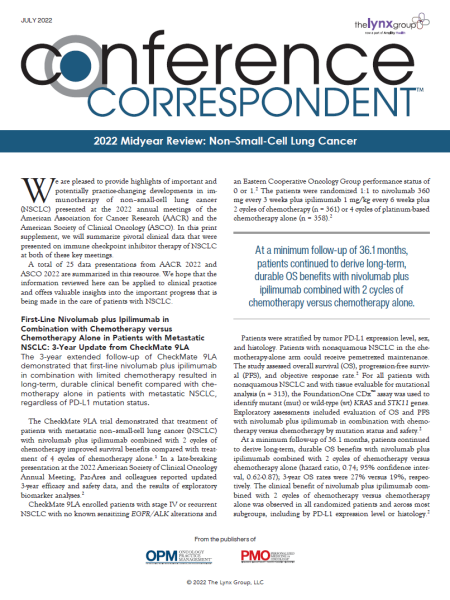The discovery of chromosomal rearrangements resulting in oncogenic fusions has revealed new drug targets and highlighted the importance of molecular biomarker identification for many types of cancer. One example is rearrangement during transfection (RET) fusions, wherein the RET receptor tyrosine kinase fuses with a partner molecule, and this fusion is capable of oncogenic activity.1-4
Typically, RET is present on the surface of tissues in the nervous system, adrenal medulla, and thyroid, among other tissues.1,5 It is important for renal organogenesis and development of the enteric nervous system as well as for neural crest development.2,6 The RET receptor contains 3 domains (ie, extracellular domain, transmembrane domain, and intracellular tyrosine kinase domain), and activation of RET requires indirect ligand binding to form a multimeric protein complex.2,7 These ligands belong to the glial-derived neurotropic factor (GDNF) family and bind to a GDNF family receptor-alpha.8 This complex then mediates RET dimerization and autophosphorylation, which activates RET.7 Once activated, RET engages intracellular signaling pathways, including the mitogen‐activated protein kinase, PI3K/AKT, and Janus kinase/signal transducer and activator of transcription (JAK/STAT) pathways.1,2 Activation of these pathways results in cell proliferation, migration, survival, and differentiation.2,8
Changes in RET can be associated with a gain or a loss of function. Loss-of-function mutations in RET can result in Hirschsprung’s disease or congenital absence of enteric ganglia.1,2 Gain-of-function changes, including mutations and fusions, have been associated with malignancy.1,2 Chromosomal rearrangements involving RET generate fusion transcripts that pair the 3′ end of RET with the 5′ end of another gene.2 These fusions can result in ligand-independent activation of RET, and because in all fusions the tyrosine kinase function of RET is preserved,2 this results in unchecked cellular proliferation.1,3 Several fusion partners have been identified for RET, including CCDC6, NCOA4, PRKAR1A, TRIM24, and KIF5B.1,2 RET mutations or fusions have been identified in papillary thyroid cancer (RET fusions present in 5%-40%), medullary thyroid cancer (gain-of-function point mutations present in up to 50% of patients), and non–small-cell lung cancer (NSCLC; RET rearrangements present in 1%-2%).2 In addition, germline mutations in RET are present in patients with multiple endocrine neoplasia.3
Similar to other oncogenic driver mutations in lung cancer, RET fusions in NSCLC are typically associated with patients who are younger in age (<60 years), female, nonsmokers, and of Asian descent.1,8 RET fusion partners identified in NSCLC include KIF5B, CCDC6, TRIM33, and NCOA4. Whereas CCDC6, TRIM33, and NCOA4 have also been identified as fusion partners in papillary thyroid cancer, KIF5B is the most common fusion partner in NSCLC.2
There is significant evidence that RET fusions may be meaningful drug targets in NSCLC.1,2 In cell-line studies, treatment of cells expressing the KIF5B-RET fusion with multikinase inhibitors with anti-RET activity result in inhibition of growth.2 These agents have modest clinical activity.8 However, selective RET inhibitors have demonstrated significant clinical activity and manageable toxicity.8 As early trials have demonstrated clinically meaningful efficacy, the evidence that RET rearrangements in NSCLC may be treatable with targeted RET inhibitors is encouraging and may predict a paradigm shift in the treatment of patients with RET-positive NSCLC.8
References
- O’Leary C, Xu W, Pavlakis N, et al. Rearranged during transfection fusions in non–small-cell lung cancer. Cancers (Basel). 2019;11:620.
- Gainor JF, Shaw AT. Novel targets in non–small-cell lung cancer: ROS1 and RET fusions. Oncologist. 2013;18:865-875.
- Kato S, Subbiah V, Marchlik E, et al. RET aberrations in diverse cancers: next-generation sequencing of 4,871 patients. Clin Cancer Res. 2017;23:1988-1997.
- Takeuchi K. Discovery stories of RET fusions in lung cancer: mini-review. Front Physiol. 2019;10:216.
- Takaya K, Yoshimasa T, Arai H, et al. Expression of the RET proto-oncogene in normal human tissues, pheochromocytomas, and other tumors of neural chest origin. J Mol Med (Berl). 1996;74:617-621.
- Ibáñez CF. Structure and physiology of the RET receptor tyrosine kinase. Cold Spring Harb Perspect Biol. 2013;5:a009134.
- Drilon A, Hu ZI, Lai GGY, Tan DSW. Targeting RET-driven cancers: lessons from evolving preclinical and clinical landscapes. Nat Rev Clin Oncol. 2018;15:151-167.
- Ackermann CJ, Stock G, Tay R, et al. Targeted therapy for RET-rearranged non–small-cell lung cancer: clinical development and future directions. Onco Targets Ther. 2019;12:7857-7864.

